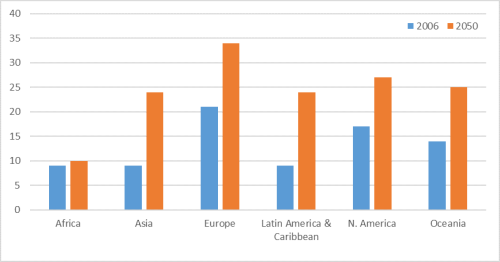
Vanessa Hale
Director, Research


Director, Research
An ageing population is not unique to the UK. Indeed, being widespread across the world different nations have approached the challenge of housing and caring for their older populations in a variety of ways.
Figure 1: Percent Distribution of World Population 60 or over by Region, 2006 and 2050

USA
The US is in a similar scenario to the UK inasmuch as it faces a significant expansion in its senior population. By 2030, more than 20% of the US population will be aged 65-plus, roughly 75 million people. This age cohort relies on fixed income, so affordability will become an issue, although demand for retirement homes is set to rise. Continuing care retirement communities (CCRCs) are growing in popularity, with over 2,000 now operating. They offer independent living, residential amenities and long-term care. Entrance fees are in the region of £165,000 and service charges average £1,700 a month. A lesson for the UK would be to try and ensure facilities are as flexible as possible to allow for ease of future conversion as the residents within a community age.
Australia
Of those aged 65-plus, just over 5% live in retirement communities. This has traditionally been a not-for-profit system that allows for low upfront costs. Today, this is encouraged through a deferred management fee that offers a licence to occupy with an exit fee, generally 30-40% of the sale value. In Western Australia, the Local Area Coordination (LAC) model focuses on offering bespoke solutions whereby individuals, families and communities can tailor needs to local situations, ensuring a more personalised needs based assessment that diverts older residents from more expensive crisis services.
New Zealand
Retirement developments started in the not-for-profit sector and have evolved into thriving communities. Currently, 5% of those aged 65-plus live in retirement housing and there has been sustained growth in CCRCs to around 350. Many residents buy through an occupational right agreement with exit fees that give the outgoing resident around 70-80% of the purchase value. Operators often retain the capital growth in the value of the home. The communities are governed by the Retirement Villages Act 2003 which, as in Australia, is there to protect the interests of residents and retirement village operators.
Japan
Japan has the largest proportion of 65-plus citizens of any developed nation. In 2000, the country’s healthcare system was reformed and mandatory long-term care insurance (LTCI) was introduced.
This has been designed to distinguish between the health system and the care system, and to increase transparency about the long-term needs of older people, with the overall aim of helping people to stay in their own homes for as long as possible, mainly through substantial support for home adaptations and an emphasis on institutional rehabilitative services. In addition, there are community awareness programmes. A 10-year nationwide campaign to raise awareness of dementia seeks to have volunteers within communities to assist with the growing numbers of people with dementia.
Europe
Europe has a challenge of ageing populations across many countries. Across Europe, Ageing Well has identified a number of priorities including 1) maintaining socialising through contact with family and friends, and 2) maintaining a healthy diet and active lifestyle. Technology has a part to play both in meeting socialising and diet objectives, but also enabling people to stay in their homes. The GiraffPlus project is funded by the European Community’s Framework Programme Seven (FP7). It aims to allow people to stay in their homes for longer through home sensors, online engagement with health workers and home robots.
Many different approaches to elderly care, extra care and dementia care are being operated across Europe, with high levels of innovation and social inclusion. For example, co-housing for older people is prevalent in Sweden, Denmark, the Netherlands and also Finland.
View the full report here.